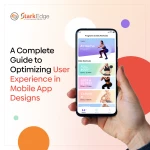In today\'s digital era, where smartphones have become an indispensable part of our lives, creating a mobile app with exceptional user experience (UX) is paramount for success. User experience encompasses every aspect of interaction between a user and a digital product. When it comes to mobile apps, it can make or break the success of your product. To ensure your mobile app stands out in a saturated market and keeps users engaged, here\'s a comprehensive guide on optimizing user experience in mobile app designs.
Understand Your Users
Before starting the design process, it\'s crucial to understand your target audience. Conduct thorough research to identify their needs, preferences, behaviors, and pain points. Use techniques like user personas, surveys, interviews, and analytics data to gain insights into user demographics and behavior patterns.
Simplify Navigation
Mobile screens are limited in size, so it\'s essential to keep navigation simple and intuitive. Use familiar navigation patterns such as bottom tabs, hamburger menus, or swipe gestures to make it easy for users to find what they\'re looking for without getting lost in complex menus.
Prioritize Content
Content is king, especially on mobile devices where screen real estate is limited. Prioritize essential content and features and present them prominently to users. Avoid cluttering the interface with unnecessary elements that could distract or overwhelm users.
Optimize Performance
Speed is critical in mobile app UX. Users need more patience for slow-loading apps or laggy interactions. Optimize your app\'s performance by minimizing loading times, reducing app size, and optimizing images and other media assets. Utilize techniques like lazy loading and caching to deliver a smooth and responsive experience.
Focus on Accessibility
Accessibility should be a fundamental aspect of mobile app design. Ensure that your app is accessible to users with disabilities by following accessibility guidelines such as WCAG (Web Content Accessibility Guidelines). Provide features like text resizing, voice commands, and alternative text for images to make your app usable for everyone.
Design for Touch
Mobile devices rely heavily on touch interactions, so design your app with touch in mind. Use large, tappable elements and provide ample spacing between interactive elements to prevent accidental taps. Consider the ergonomics of different device sizes and orientations to ensure a comfortable and seamless experience for users.
Consistent Branding
Maintain consistent branding across all touchpoints of your app, including colors, typography, imagery, and tone of voice. Consistency builds trust and familiarity with users, reinforcing your brand identity and making your app more memorable.
Provide Feedback
Feedback is essential for guiding users and confirming that their actions have been successful. Incorporate visual and auditory cues such as animations, progress indicators, and sound effects to provide instant feedback and keep users informed about their interactions with the app.
Test Continuously
User testing is crucial for identifying usability issues and gathering feedback for improvement. Conduct usability testing with real users throughout the design and development process to validate design decisions and uncover areas for refinement. Iterate based on user feedback to continuously improve the user experience.
Stay Updated
The mobile landscape is constantly evolving, with new technologies and trends emerging regularly. Stay updated with the latest advancements in mobile app design, platform guidelines, and user expectations to ensure your app remains relevant and competitive in the market.
Conclusion
By following these guidelines and prioritizing user experience in your mobile app designs process, you can create a compelling and engaging experience that keeps users coming back for more. Remember, a great user experience not only delights users but also drives business success in the long run.



